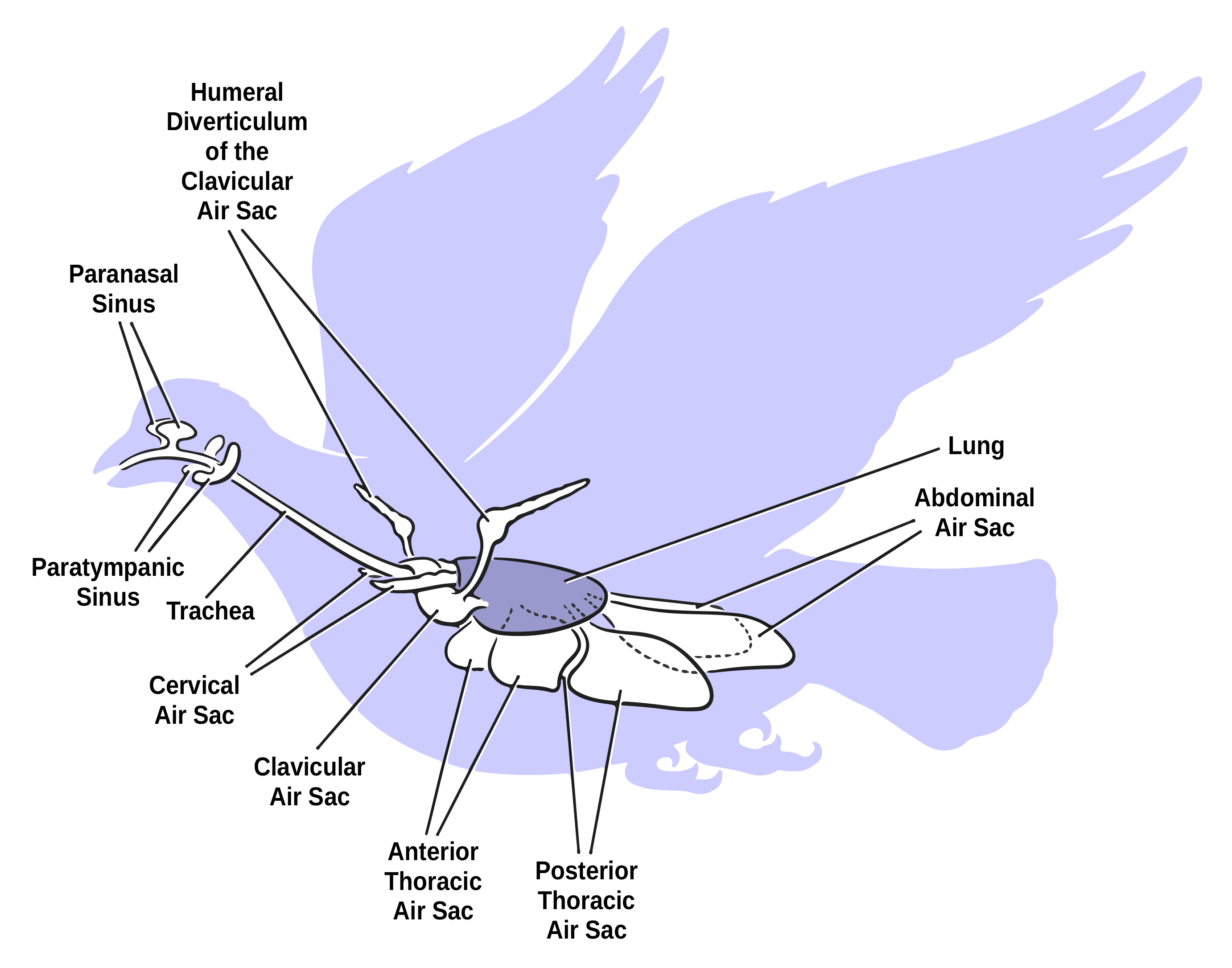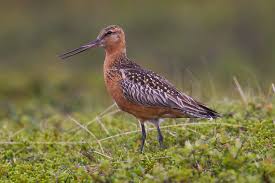 RESPIRATION: The anatomy of the avian respiratory system is quite complex compared to that of mammals. The avian and mammalian respiratory systems consist of the lungs which expand, gas exchange occurs and the air is exhaled. In birds the respiratory system also serves for the exchange of gases but is also important in eliminating heat from the body and has several non-respiratory functions such as the detoxification of metabolic products and vocalization. As in mammals, the upper respiratory system serves to filter air to trap dust. Unlike mammalian lungs, avian lungs are relatively rigid and do not move much during breathing.
RESPIRATION: The anatomy of the avian respiratory system is quite complex compared to that of mammals. The avian and mammalian respiratory systems consist of the lungs which expand, gas exchange occurs and the air is exhaled. In birds the respiratory system also serves for the exchange of gases but is also important in eliminating heat from the body and has several non-respiratory functions such as the detoxification of metabolic products and vocalization. As in mammals, the upper respiratory system serves to filter air to trap dust. Unlike mammalian lungs, avian lungs are relatively rigid and do not move much during breathing.
Emanating from the lungs are thin-walled air sacs that fill most of the body cavity not occupied by other viscera; most birds have nine. Some air sacs penetrate the interior of the bones and even under the skin. In mammals, inspired air goes into the lung as the lung expands and is expired when the lung contracts. See video. In birds the lungs expand very little because the air goes through them into the air sacs and back through the lungs on expiration. Thus not only can a greater volume of air pass through the lungs, but since it passes through twice, gas exchange is more efficient.
In addition, birds’ lungs have more capillaries/area than mammals. Air sacs also provide buoyancy for aquatic birds; swimming species have particularly large abdominal and post-thoracic air sacs whose volume can be controlled for swimming or diving. They also provide a cushion for the viscera when landing nor diving in to the water for food, and may be modified for courtship displays e.g. the neck bladders of the Frigate Bird and Prairie Chicken. Air sacs also serve to cool the body during vigorous exercise through the internal evaporation of water. Breathing rate obviously increases with activity. E.g. a House Sparrow has a resting respiratory rate of 50/min which increases to over 200 after flying around a room.
There isn’t a lot of information on respiratory rate and oxygen consumption during flight simply because it’s difficult to get. The classic experiments are those of Tucker (1968 J. Exp. Biol.) in which he trained parakeets and gulls to fly in a wind tunnel . Tucker’s budgerigar study showed that respiration seems to be most efficient at a certain flight speed; in this case about 35 kph. This may be due to a coordination of wing beats with respiration. There’s evidence from ducks, crows, and pigeons that they maintain a consistent cycle of from 3-5 wing beats per breath. This indicates that the flight muscles somehow enhance the movement of air through the respiratory system. Avian Respiratory Dynamics in action.
 CIRCULATION: The circulatory system, the heart, blood vessels, lymphatic system, etc., has the same purpose and function as it does in other vertebrates-transport of foods, gases, hormones, and waste
CIRCULATION: The circulatory system, the heart, blood vessels, lymphatic system, etc., has the same purpose and function as it does in other vertebrates-transport of foods, gases, hormones, and waste
products. Only in birds and mammals and crocodilians is the heart four-chambered. The heart of birds is relatively larger and more powerful than that of reptiles and mammals of similar size; perhaps 50-100% larger. The heart of small birds is also proportionately larger than that of larger birds and is related to their respiratory rate. The measurement of heart rates vary because birds are so excitable when restrained. Heart Rates blue jay 165 turkey 270 robin 550 canary 400-800 blue-winged teal 1000 hummingbird 1200 Blood pressure is also higher in birds than in other vertebrates: pigeon 135/105 mmHg chicken 180/160 starling 180/130 canary 220/154 turkey 235/141.
The circulatory system structure of birds is basically like that of vertebrates although there are some modifications. For example, the two jugular veins of the head are cross-connected so that a severe twist of the head doesn’t cut off blood drainage. Typically, birds’ veins and arteries are set up so that the veins and arteries lie next to each other. Thus the warm blood leaving the heart and going to the extremities warms the cooler blood going to the heart from the extremities; thus some heat is returned to the body core and conserved. This is countercurrent heat exchange and is typical of cold environment birds. In warm environments, the venous return from the appendages is superficial so that heat is just radiated to the atmosphere.
FLIGHT: Many of the physiologic adaptations of the respiratory and circulatory systems are related to the energetic needs for flight. Although flying is an efficient way to move, it is also energy-intensive. The heart rate of small birds doubles from the resting rate when flying and goes to 3x or 4x in larger birds. For long-distance migrants, where energy considerations are especially important, birds typically lose 25% of their body weight and even up to 50%, which seems to be a physiological maximum. Hummingbirds fly over the Gulf of Mexico (800km) and Golden Plovers fly 3900km from the Aleutian to the Hawaiian Islands non-stop. Generally, the larger the bird, the farther they can fly, either non-stop or on a long migration. Many non-stop flights observed (Homing pigeon 1080km or 600 miles; Alpine swift 540km or 300 miiles, I) were probably done with a tail wind).
But one spectacular non-stop flight needs to be noted. The Bar-tailed Godwit (below) migrates in flocks to coastal East Asia, Alaska, Australia, Africa, northwestern Europe and New Zealand.
It was shown in 2007 to undertake the longest non-stop flight of any bird. Birds in New Zealand were tagged and tracked by satellite to the Yellow Sea in China. According to Dr. Clive Minton (Australasian Wader Studies Group): “The distance between these two locations is 9,575 km (5,950 mi), but the actual track flown by the bird was 11,026 km (6,851 mi). This was the longest known non-stop flight of any bird. The flight took approximately nine days. At least three other bar-tailed godwits also appear to have reached the Yellow Sea after non-stop flights from New Zealand.”
One specific female of the flock, nicknamed “E7”, flew onward from China to Alaska and stayed there for the breeding season. Then on 29 August 2007 she departed on a non-stop flight from the Avinof Peninsula in western Alaska to Thames, New Zealand, setting a new known flight record of 11,680 km (7,258 mi).
In the last paragraph, prior to the paragraph labeled FLIGHT, the sentence is incomplete without any end of sentence punctuation.
Thanks for pointing that out. I fixed it.